*This story is part of a special project on Innovators in Latin American and Caribbean Journalism.
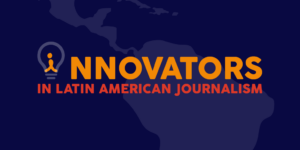 In Mexico it is common to hear the phrase "a little bird told me" when someone shares information whose source you can not (or do not want) to reveal.
In Mexico it is common to hear the phrase "a little bird told me" when someone shares information whose source you can not (or do not want) to reveal.
That phrase had never made so much sense for journalism in the country as when journalist and media businessman Daniel Eilemberg chose a green-headed bird as the central character of what would become one of Mexico's most influential digital native news media outlets.
The bird emerged on Twitter as @pajaropolitico (“politics bird”) in October 2009, a time when digital native media had not yet taken off in Mexico and the consumption of news on the internet was almost exclusively through newspapers’ websites, which were essentially replicas of the print versions.
Eilemberg invited Mexican journalist Daniel Moreno to be in charge of the @pajaropolitico project. The bird had a specific objective: to be a character that informed and held a direct conversation with the users of that social network. That evolved into what is now a native digital media outlet that set out to innovate in form and content with topics that were practically absent from traditional Mexican media.
The innovation of @pajaropolitico began with that direct dialogue that few of the traditional media had with their readers. That's why, from the beginning, Moreno put a team of journalists in charge of the Twitter account.
"It's a team that confirms information," said Tania Montalvo, editor general of Animal Político. "If you send a message to any media in this country or a complaint, the truth is that you rarely have an answer, and we work in a totally opposite way. I am not working for the politician to read it, but for the citizens. I think that distinguishes us and I also think that readers value it very much.”
That dialogue was a determining factor a year later, when @pajaropolitico went on to launch its website. Moreno and his team realized that the topics that most interested their Twitter followers were corruption, the environment, violence and the lack of accountability of politicians, topics that traditional media reported, but did not investigate thoroughly.
 Throughout his career of almost 30 years in journalism, and his time in the most influential newspapers in Mexico, such as Reforma, El Universal, Milenio, Excelsior, El Financiero and El Economista, Moreno could see that these issues were reported by traditional media, but not thoroughly investigated.
Throughout his career of almost 30 years in journalism, and his time in the most influential newspapers in Mexico, such as Reforma, El Universal, Milenio, Excelsior, El Financiero and El Economista, Moreno could see that these issues were reported by traditional media, but not thoroughly investigated.
"The fact that we have addressed in an almost obsessive manner the issues of corruption and human rights has made an important difference in a country where journalism tends to be very political. I think we have had the virtue of addressing these issues over traditionally political sources," said Moreno, now general director of Animal Político. "The investigations to reveal cases of corruption are not - by far - something common in the Mexican media. And in the case of human rights, the norm is to count the dead, reproduce the official version, revictimize the victims."
Animal Político, considered one of the first exclusively digital media outlets in Mexico, was launched in November 2010 with the intention of working on these issues. At that time, native U.S.-based digital native news sites like The Huffington Post and Politico were in full expansion mode.
Animal Político noticed that the majority of its audience was between 25 and 35 years old, and they realized that this sector of audience was not satisfied with the journalism of statements, but demanded harder evidence. For this reason, the site drew upon data journalism to support its reports. The editors knew it was important to know how to communicate that information to their audience.
"Supporting a journalistic investigation with data, hard information, evidence and documents should be a requirement to be met by any journalistic investigation," Moreno said. "I am convinced that the journalists of Animal Político have learned how to use databases, how to process information, how to extract from the documents highly relevant journalistic information, how to cross the data to find coincidences and revelations."
The site’s team has made data management a part of their daily routine. Montalvo, led Animal Político’s project NarcoData in 2015, one of the most representative projects of data journalism in Mexico. It is the first interactive digital platform that explains the presence and evolution of organized crime in Mexico since the 70s.
Thanks to this management of data journalism, the work of Animal Político has had an impact on the reality of their country on more than one occasion. One of its most emblematic reports is "Las Empresas Fantasma de Veracruz" (The Ghost Companies of Veracruz), published in 2016, which revealed how the government of the state of Veracruz used a network of fictitious corporations to divert millions of pesos.
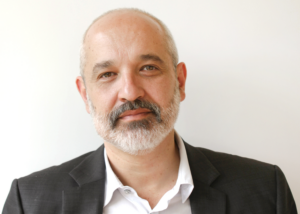
Daniel Moreno, general director of Animal Político (Courtesy)
The project has a series of articles, infographics, videos and documents which were used to thoroughly explain the corruption scheme used by then-Governor Javier Duarte, who is currently in prison.
"I tell you without hesitation, without the report Javier Duarte would never have been investigated," Tania Montalvo said. "He initially denied everything, but we continued to publish the evidence, and the pressure was so great that he resigned and escaped the country."
As a result of "The Ghost Companies of Veracruz," which was carried out in collaboration with the organization Mexicanos contra la Corrupción y la Impunidad, Animal Político put the issue of corruption at the center of the media political coverage, largely thanks to the way in which they presented such complex information, so that it was easy to understand.
For the distribution of the report in social networks, the editors decided to use emojis, which was not common for a serious media outlet, especially with a subject as heavy as corruption. The result was that the content also reverberated in audiences that don’t frequently consult hard news.
"It was an editorial decision that finally had very good results," Yosune Chamizo, the site’s information designer, told the Knight Center. "That kind of thing has helped us get closer to new sectors, because at the end of the day Animal Político has very serious information, and there is a group of people maybe are not interested in this kind of content.”
The report earned author Arturo Ángel Mendieta the prestigious Walter Reuter German Award for Journalism, which recognizes Mexican journalism. The announcement of the award said the jury considered “it is one of the highest impact works in recent years in Mexico” and that it was “fundamental in exposing the excesses and abuses of a government like that of Javier Duarte de Ochoa.”
Ángel and journalist Víctor Hugo Arteaga also won the National Mexican Journalism Award in 2016 in the category of Investigative Report. In the announcement of the winners, the jury noted the “rigorous work of crossing information, verification of official data and on-site investigation, presented in a multimedia format.”
But the team behind Animal Político’s special reports goes beyond the people whose bylines grace the article. The site has learned that the scope of a report is multiplied when members of all areas of the newsroom are involved in carrying it out from the beginning.
"We work on the investigations as a team, it's never a single person doing it, it's a team of eight or ten people," Montalvo said. "There are two reporters with totally different skills who work together and who from the beginning are working with the editor with an external perspective, but also with a video team, a design team, with an audience editor. So the impact is much greater."
"It is a current need in media to have these three-part teams: programmer – journalist/communicator – information designer," Chamizo said. "This three person combo with these profiles is what makes it possible to do specials like this.”
The art of knowing how to present information
When working with huge amounts of data for a journalistic product, the design of information becomes fundamental. Therefore, the site decided to strengthen its team of multimedia journalists in January 2017 with a new video and design strategy and also created the position of information designer for Chamizo, who has experience in data visualization and a Master's degree in information design. The goal was to create multidisciplinary teams to meet the demand for formats that readers of native digital media demand, which is more visual, understandable and easy to share in networks.
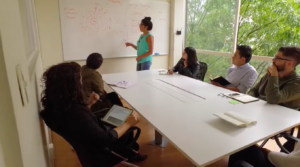
Journalists from the site learn that while content is the most important thing, the way in which it is presented is also fundamental. (Screenshot)
"La Estafa Maestra" (The Master Fraud), another of the special projects from Animal Político that has had significant impact, utilized Chamizo’s prowess with information organization as well as the multimedia team’s presentation skills. It is a complex investigation that reveals a diversion scheme that involves dependencies of the federal government, public universities and ghost companies.
The report, which was published on Jan. 10, 2018, involved the analysis and organization of multiple databases and information of three reporters.
"Each reporter works in a different way, and then you have to gather the information, because it is not necessarily standardized information," Chamizo said. "There were several months - two or three - for nothing more than to gather the information of the three reporters in a unified database to be able to measure what was happening. It was a fundamental step, and without that step we would not have published yet.”
Thanks to the information design application, this huge amount of data could be translated into elements that are much easier to consume. The investigation was presented in several text, video and infographics reports and even a comic. Each of these elements was aimed at the preferences of different types of audiences.
"It's a way to make information simpler, to simplify it without trivializing it," Montalvo said. "With the videos of 'The Master Fraud', you saw them and you understood the fraud perfectly. But that did not mean that we lost views in longform text reports. There were entirely different audiences who were looking for different ways to find out what 'The Master Fraud' was."
According to Moreno, the attention to formats and the strengthening of the multimedia team translated into a significant increase in Animal Político’s audience in 2017, in which it saw its highest number of readers in its almost eight years of existence.
"Last year we ended up with more than double the 2016 figures," Moreno said. "I am convinced that it was the sum of all those things, and one of them is the work of the video team."
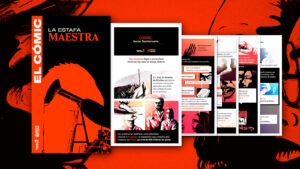
“The Master Fraud” included a comic that explained a complex diversion scheme. (Screenshot)
Betting everything on Facebook and Twitter is a mistake
For a native digital media outlet, a powerful strategy in social networks is of the utmost importance. The Animal Político team is aware of this, which is why it created the position of audience editor as a key position in its newsroom.
The audience editor is not only in charge of the site’s two community managers, but also actively participates in the creation of the content, planning of specials and proposals for the presentation of the information.
"Talking about Animal Político and talking about it solely as a social media strategy is not giving the whole picture," audience editor Jorge Ramis said. "It's a 360 strategy. It's thinking of it a bit in terms of marketing, not just concentrating ourselves on networks, but seeing all the types of channels for which an audience wants to receive information and try to be there."
One of those channels is the newsletter to which readers can subscribe for free. One of Animal Político’s priorities for 2018 is to strengthen this tool for attracting traffic to its site from email. In addition, they are considering the implementation of distribution channels for their content through WhatsApp or Telegram.
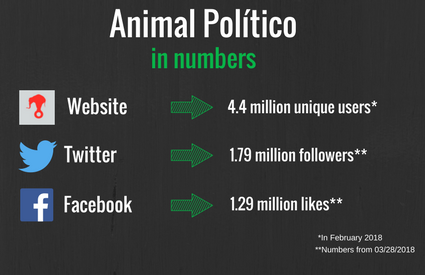 However, about 60 percent of Animal Político’s traffic comes from organic searches, 25 percent is direct access to the site, and only 15 percent comes from social networks. Ramis attributes the above to his team making sure that their SEO is highly optimized. The site has confirmed that basing a strategy solely on Facebook and Twitter is a mistake.
However, about 60 percent of Animal Político’s traffic comes from organic searches, 25 percent is direct access to the site, and only 15 percent comes from social networks. Ramis attributes the above to his team making sure that their SEO is highly optimized. The site has confirmed that basing a strategy solely on Facebook and Twitter is a mistake.
"You have to look at other channels, networks are not everything, you have to think outside the box," Ramis said. "Media that based everything on paid posts on Facebook, are now falling in traffic. We do not, because we turn to see other sides."
In February 2018, Animal Político registered a total of more than 8.8 million visits, and attracted 4.4 million unique users. In smartphones -the main platform in which Animal Político is consumed- it placed among the three most read digital native news media in Mexico, with 3.6 million unique visitors, just below UNOTV.com (7.7) and SDP News ( 6.1).
The team attributes the good numbers in January and February to a large extent to its "Master Fraud" special, which has been the site’s most consumed story on social networks so far this year, and to the fact that it has involved the audiences team from the beginning of the project. They also note the diversification of formats in which the project was presented.
"When you involve an audience editor, a community manager, the conversation changes and they can come up with ideas that are different from what is normally done," Ramis said. "The team of audience editors proposed the title ‘La Estafa Maestra,’ and the hashtag. It was a great brainstorm in which many more minds with different profiles are involved and that is was ensured that the team work has been so productive and that the product has been a success.”
Pioneers in fact-checking
Since January 2015, Animal Político was given the task of evaluating the discourse of politicians in order to find inconsistencies and false information. El Sabueso (the Bloodhound) is the name of the site’s fact-checking project, which uses a methodology inspired by the leading fact-checking sites: Politifact and Chequeado, from the United States and Argentina, respectively.
After three years, El Sabueso is one of the few fact-checking efforts that have been kept alive in Mexico, and it is the only one with recognition from the Poynter Institute.
At election time, fact-checking becomes a fundamental tool for journalists seeking to expose false information or the use of data manipulated by candidates. That is why Animal Político joined AJ+ and Pop-Up Newsroom to convene more than 60 media, both digital and traditional, to take their project to verify the discourse to another level.
This is how Verificado 2018came about in preparation for the country’s presidential election. The project, which launched on March 12, has its own website and accounts on social networks. Since that day, dozens of notes have been released with the #Verificado2018 seal, which means that it is information that has been analyzed and rated according to their level of truthfulness.
"I am convinced that Verificado 2018 is an evolution of El Sabueso," Moreno said. "The spirit has been to serve the reader from a different format that consists of raising the cost of lying, not allowing the political class to be able to lie to people with impunity.”
The site has joined forces with newsrooms like Mexicanos Contra la Corrupción y la Impunidad or AJ+, as well as with independent journalists, in order to carry out investigations. They’ve also given courses on methodology and investigative journalism to close to a dozen media.
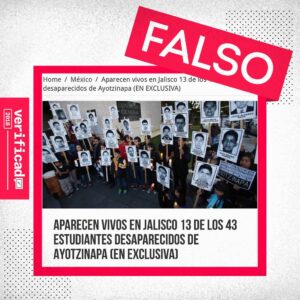
Verificado 2018 is a project between AJ+ en Español, Animal Político, Pop-Up Newsroom and other allied media. (Facebook)
“Regarding Animal Político’s innovations, I would also add that we have opted for collaborative work," Moreno said. "I start from the basis that collaborative work is indispensable for the challenges that independent media and journalists throughout the country have."
The site has also made strategic alliances to disseminate their content with media from the interior of Mexico and smaller newsrooms. And collaboration has even occurred in sharing the physical space for their newsroom.
After the earthquake in Mexico City on Sept. 19, 2017, Animal Político’s office building suffered significant damage and had to be evicted. Despite not having a physical newsroom, the team intensified its work and developed the coverage #Sismo19S, with the support of Mexicanos Contra la Corrupción y la Impunidad, which hosted them in their facilities.
Alliances with other media also have commercial and business advantages. In 2018, Animal Político joined Grupo Editorial Criterio, which publishes the magazine Newsweek en Español and operates several newspapers in different states in the country. The objective is to take advantage of the commercial strength of a well-positioned traditional media outlet and at the same time to take advantage of new channels to disseminate content.
"They have a lot more experience to do business, sales, which was very complicated and we did not have as much capacity to do," Montalvo said. "Newsweek is a huge broadcasting channel. Reading content from Animal Político in Newsweek gives you a plus. "
Before this alliance, Animal Político had to make great efforts for its financing, like most independent media. The majority of its revenue -45 percent- come from advertising via programmatic advertising, and another important portion -25 percent- from courses and consultancy to other companies.
From the beginning the site had grants for specific projects, although recently that type of funding amounted to 25 percent of its total funding, thanks to contributions from organizations such as Open Society Foundations and Ford Foundation. In addition, thanks to its #ElijoAnimal campaign, 5 percent of its revenue comes from crowdfunding.
Much of its advertising comes from Animal Gourmet, its vertical site that focuses on food and food, which is more attractive to advertisers. In this way they have been able to avoid government advertising, which allows them to reinforce their image as an independent media.
"We are not the only media that does not receive publicity from the federal government, but I do believe that we are one of the few that openly demand regulation of official advertising," Montalvo said. "We are with civil organizations that are promoting a regularization of the issue so that it is not used in the rest of the press for a form of control and censorship, and I believe that readers also distinguish it."
With the growth it has achieved over almost eight years, and after having positioned itself as a credible media, Animal Político plans to continue expanding its reach through the creation of newsrooms in other Mexican states, or even to bring its journalistic brand to other Latin American countries.
Additionally, they will continue to explore new languages and forms of bringing information to their readers.
"Today Animal Político is more than I had imagined," Moreno said. "We have had the ability to adapt to time, to reimagine the content, the languages, to rethink how to converse with readers. All that has been rethought every day. So yes we say that we are in the spirit to imagine an ambitious future."
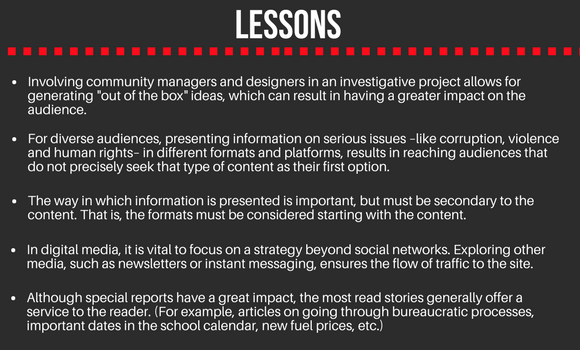
The "Innovators in Journalism" series, made possible thanks to generous support from Open Society Foundations, covers digital news media trends and best practices in Latin America and the Caribbean. It expands upon our previous series and ebook, Innovative Journalism in Latin America, by looking at the people and teams leading innovative reporting, storytelling, distribution and financing initiatives in the region.